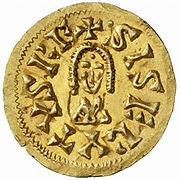
Sisebur
Encyclopedia

Visigothic Kingdom
The Visigothic Kingdom was a kingdom which occupied southwestern France and the Iberian Peninsula from the 5th to 8th century AD. One of the Germanic successor states to the Western Roman Empire, it was originally created by the settlement of the Visigoths under King Wallia in the province of...
of Hispania
Hispania
Another theory holds that the name derives from Ezpanna, the Basque word for "border" or "edge", thus meaning the farthest area or place. Isidore of Sevilla considered Hispania derived from Hispalis....
, Septimania
Septimania
Septimania was the western region of the Roman province of Gallia Narbonensis that passed under the control of the Visigoths in 462, when Septimania was ceded to their king, Theodoric II. Under the Visigoths it was known as simply Gallia or Narbonensis. It corresponded roughly with the modern...
and Galicia
Kingdom of Galicia
The Kingdom of Galicia was a political entity located in southwestern Europe, which at its territorial zenith occupied the entire northwest of the Iberian Peninsula. Founded by Suebic king Hermeric in the year 409, the Galician capital was established in Braga, being the first kingdom which...
from 612 until his death.
He campaigned successfully against the remains of Byzantine
Byzantine Empire
The Byzantine Empire was the Eastern Roman Empire during the periods of Late Antiquity and the Middle Ages, centred on the capital of Constantinople. Known simply as the Roman Empire or Romania to its inhabitants and neighbours, the Empire was the direct continuation of the Ancient Roman State...
power in Spania
Spania
Spania was a province of the Roman Empire from 552 until 624 in the south of the Iberian Peninsula and the Balearic Islands. It was a part of the conquests of Roman Emperor Justinian I in an effort to restore the western half of the Empire....
, strengthened Visigothic control over the Basques and Cantabri
Cantabri
The Cantabri were a pre-Roman Celtic people which lived in the northern Atlantic coastal region of ancient Hispania, from the 4th to late 1st centuries BC.-Origins:...
ans, developed friendly relations with the Lombards
Lombards
The Lombards , also referred to as Longobards, were a Germanic tribe of Scandinavian origin, who from 568 to 774 ruled a Kingdom in Italy...
of Italy
Italy
Italy , officially the Italian Republic languages]] under the European Charter for Regional or Minority Languages. In each of these, Italy's official name is as follows:;;;;;;;;), is a unitary parliamentary republic in South-Central Europe. To the north it borders France, Switzerland, Austria and...
, and reinforced the fleet which had been established by his predecessor Leovigild.
In 616, he ordered that those Jews who refused to convert to Christianity
Christianity
Christianity is a monotheistic religion based on the life and teachings of Jesus as presented in canonical gospels and other New Testament writings...
should be punished with the lash. He was closely associated with the scholar and encyclopaedist Isidore
Isidore of Seville
Saint Isidore of Seville served as Archbishop of Seville for more than three decades and is considered, as the historian Montalembert put it in an oft-quoted phrase, "le dernier savant du monde ancien"...
, bishop of Seville
Seville
Seville is the artistic, historic, cultural, and financial capital of southern Spain. It is the capital of the autonomous community of Andalusia and of the province of Seville. It is situated on the plain of the River Guadalquivir, with an average elevation of above sea level...
, and is usually regarded as the author of a Latin poem on astronomy, Carmen de Luna or Praefatio de Libro Rotarum, dedicated to a friend who is identified with Isidore.
He married firstly to an unknown wife, by whom he had a daughter Theodora, born circa 590, who married Suintila
Suintila
Suintila was Visigothic King of Hispania, Septimania and Galicia from 621 to 631. There was a new peace in the Kingdom of the Visigoths. As a direct result, by 624 the king was able to retake those lands that had been under the control of Byzantium...
, and secondly to his son in law's illegitimate sister, bastard daughter of Reccared I by Floresinda, by whom he had a son Reccared II
Reccared II
Reccared II was Visigothic King of Hispania, Septimania and Galicia briefly in 621. His father and predecessor was Sisebut and his mother was his second wife, the bastard daughter of Reccared I by Floresinda...
.

